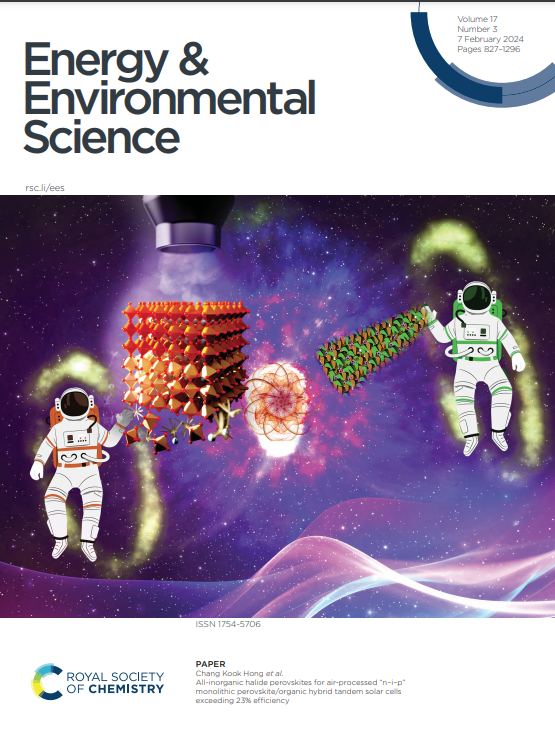Intermolecular interactions triggered crystallization phase transition regulation for efficient and stable perovskite photovoltaics
IF 32.4
1区 材料科学
Q1 CHEMISTRY, MULTIDISCIPLINARY
引用次数: 0
Abstract
The efficiency of perovskite solar cells (PSCs) has witnessed remarkable improvements, yet the unbalanced δ-to-α phase crystallization transition dynamics and defects remain significant barriers to the reproducibility and stability of devices. Herein, we utilize the guanidine oxalate (GAOA) as ionic pair stabilizer to simultaneously regulate the crystallization dynamics and stabilize α-phase perovskite. The hydrogen bonds and bidentate chelation electrostatic interactions of GAOA and Pb-I framework effectively regulate the δ-to-α crystallization phase transition rate and restrict component loss during solvent evaporation. This strategy demonstrates broad applicability for the n-i-p and p-i-n structured PSCs with the champion power conversion efficiencies (PCEs) of 25.33% and 25.37%, respectively. Besides, the active area PCEs of modules are up to 21.97% for 37.9 cm2 and 19.25% for 641.4 cm2. Furthermore, the devices retain 93% of their initial efficiency for 1000 h and 95% for 500 h according to the ISOS-D-1 and ISOS-L-1 protocols.分子间相互作用触发了高效稳定钙钛矿光伏电池的结晶相变调控
钙钛矿太阳能电池(PSCs)的效率有了显著的提高,但不平衡的δ-to-α相结晶转变动力学和缺陷仍然是器件可重复性和稳定性的重大障碍。本文利用草酸胍(GAOA)作为离子对稳定剂,调节α-相钙钛矿的结晶动力学,同时稳定α-相钙钛矿。GAOA和Pb-I框架的氢键和双齿螯合静电相互作用有效地调节了溶剂蒸发过程中的δ -α结晶相变速率,限制了组分的损失。该策略广泛适用于n-i-p和p-i-n结构psc,其冠军功率转换效率(pce)分别为25.33%和25.37%。此外,在37.9 cm2和641.4 cm2时,组件的有效面积pce分别高达21.97%和19.25%。此外,根据iso -d -1和iso - l -1协议,设备在1000小时内保持93%的初始效率,在500小时内保持95%。
本文章由计算机程序翻译,如有差异,请以英文原文为准。
求助全文
约1分钟内获得全文
求助全文
来源期刊

Energy & Environmental Science
化学-工程:化工
CiteScore
50.50
自引率
2.20%
发文量
349
审稿时长
2.2 months
期刊介绍:
Energy & Environmental Science, a peer-reviewed scientific journal, publishes original research and review articles covering interdisciplinary topics in the (bio)chemical and (bio)physical sciences, as well as chemical engineering disciplines. Published monthly by the Royal Society of Chemistry (RSC), a not-for-profit publisher, Energy & Environmental Science is recognized as a leading journal. It boasts an impressive impact factor of 8.500 as of 2009, ranking 8th among 140 journals in the category "Chemistry, Multidisciplinary," second among 71 journals in "Energy & Fuels," second among 128 journals in "Engineering, Chemical," and first among 181 scientific journals in "Environmental Sciences."
Energy & Environmental Science publishes various types of articles, including Research Papers (original scientific work), Review Articles, Perspectives, and Minireviews (feature review-type articles of broad interest), Communications (original scientific work of an urgent nature), Opinions (personal, often speculative viewpoints or hypotheses on current topics), and Analysis Articles (in-depth examination of energy-related issues).
 求助内容:
求助内容: 应助结果提醒方式:
应助结果提醒方式:


